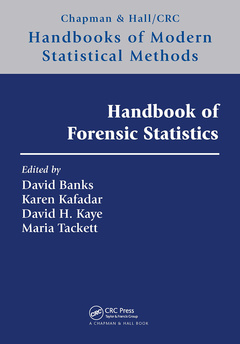Description
Handbook of Forensic Statistics
Chapman & Hall/CRC Handbooks of Modern Statistical Methods Series
Coordinators: Banks David L., Kafadar Karen, Kaye David H., Tackett Maria
Language: English
Subjects for Handbook of Forensic Statistics:
Keywords
Forensic DNA; Forensic DNA Evidence; DNA; Forensic DNA Profile; fingerprints; Forensic DNA Analysis; bite marks; NRC Report; drug testing; DNA Profile; blood splatters; DNA Evidence; eyewitness identification; DNA Match; Forensic statistics; Bayes Factor; Bayesian networks; Random Match Probability; Hypothesis testing; DNA Database; Statistical inference; Roc Curve; Statistical findings; Likelihood Ratio; Proper Scoring Rules; Allele Probabilities; Str Locus; DNA Typing; Prosecutor’s Fallacy; Data Set; DNA Mixture; Defense Attorney’s Fallacy; Cartridge Cases; LR Method; Trace Impression
Publication date: 05-2022
Support: Print on demand
Publication date: 11-2020
· 17.8x25.4 cm · Hardback
Description
/li>Contents
/li>Biography
/li>
Handbook of Forensic Statistics is a collection of chapters by leading authorities in forensic statistics. Written for statisticians, scientists, and legal professionals having a broad range of statistical expertise, it summarizes and compares basic methods of statistical inference (frequentist, likelihoodist, and Bayesian) for trace and other evidence that links individuals to crimes, the modern history and key controversies in the field, and the psychological and legal aspects of such scientific evidence.
Specific topics include uncertainty in measurements and conclusions; statistically valid statements of weight of evidence or source conclusions; admissibility and presentation of statistical findings; and the state of the art of methods (including problems and pitfalls) for collecting, analyzing, and interpreting data in such areas as forensic biology, chemistry, and pattern and impression evidence. The particular types of evidence that are discussed include DNA, latent fingerprints, firearms and toolmarks, glass, handwriting, shoeprints, and voice exemplars.
1. The history of forensic inference and statistics: a thematic perspective. 2. Frequentist methods for statistical inference. 3. Bayesian methods and forensic inference. 4. Comparing philosophies of statistical inference. 5. Decision theory. 6. Association does not imply discrimination: Clarifying when matches are (and are not) meaningful. 7. Validation of forensic automatic likelihood ratio methods. 8. Bayesian networks in forensic science. 9. How well do lay people comprehend statistical statements from forensic scientists? 10. Forensic statistics in the courtroom. 11. DNA frequencies and probabilities. 12. Kinship. 13. Statistical support for conclusions in fingerprint examinations. 14. Probabilistic considerations when interpreting data base search and selection effects. 15. Comparing handwriting in questioned documents. 16. An introduction to firearms examination for researchers in statistics. 17. Shoeprints: the path from practice to science. 18. Forensic glass evidence. 19. Estimation of insect age for assessing minimum post-mortem interval in forensic entomology casework. 20. Statistical models in forensic voice comparison. 21. Bringing new statistical approaches to eyewitness evidence.
David Banks is a professor in Department of Statistical Science at Duke University. He is a former coordinating editor of the Journal of the American Statistical Association, director of the Statistical and Applied Mathematical Sciences Institute, and a Fellow of the ASA and the Institute of Mathematical Statistics. Karen Kafadar is a Commonwealth Professor and the chair of the Department of Statistics at the University of Virginia. She is a former president of the ASA; a Fellow of the International Statistics Institute, the ASA and the AAAS; and a former member of the Forensic Science Standards Board (FSSB) of the Organization of Scientific Area Committees for Forensic Science (OSAC). David Kaye is Distinguished Professor of Law Emeritus at Pennsylvania State University and Regents’ Professor of Law and Life Sciences Emeritus at Arizona State University. He is a former editor of Jurimetrics Journal; a member of the FSSB; and the 2020 recipient of the Association of American Law Schools’ Wigmore Lifetime Achievement Award for contributions to the understanding of the proof process and the rules of evidence. Maria Tackett is an assistant professor of the practice in Department of Statistical Science at Duke University.
These books may interest you

Interpol's Forensic Science Review 196.56 €



